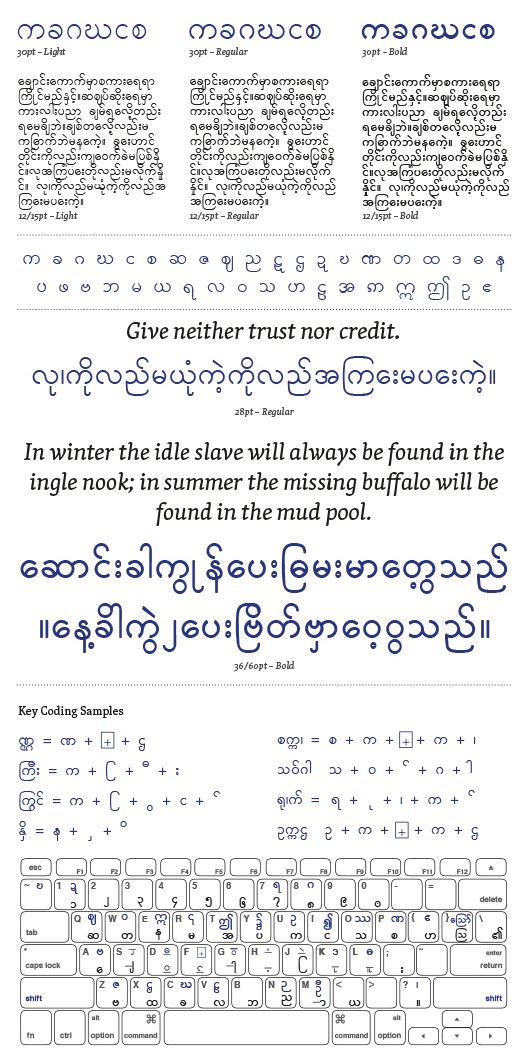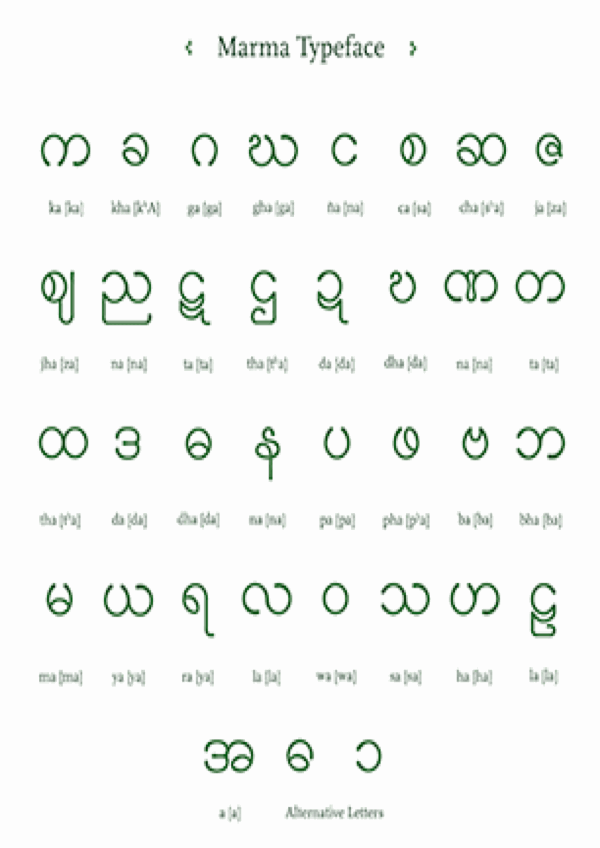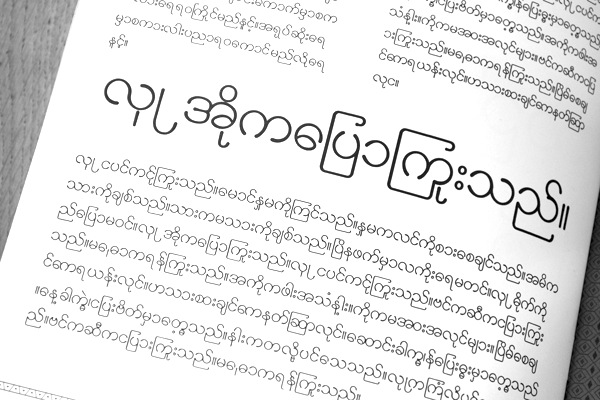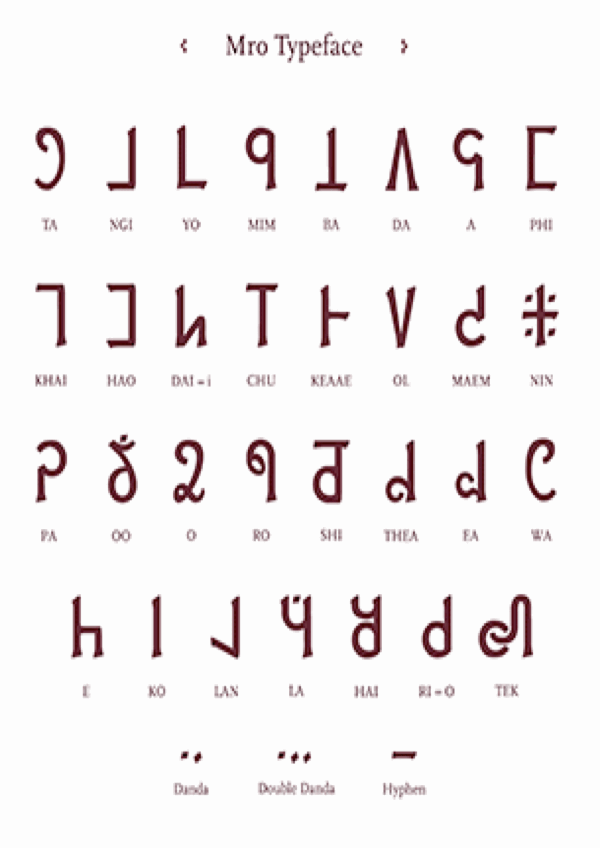TYPE DESIGN INFORMATION PAGE last updated on Sun Nov 3 07:10:27 EST 2024
FONT RECOGNITION VIA FONT MOOSE
|
|
|
|
Thomas Sanalitro
Cambridge, UK-based graphic designer and typographer. In 2013, he started work on the Marma typeface for Chakma. He writes: For my Final Major Project at Cambridge School of Art, I was asked by a teacher if I would like to join Tim Brookes and his Endangered Alphabets Project team. I jumped at the chance to join as I had a keen interest in typography, non-latin scripts and constructed languages. The Project involved the development of several endangered writting systems from the Chittagong Hill Tracts in Bangladesh. The Marmas sometimes referred as Mogh and live mostly in the Chittagong Hill Tracts. They call themselves Marma Lumya (Nue 2007). According to the Marma writer Kya Shai Pro the word Marma is derived from the mryma carrying the concept of Myanmer's nationalism. They are the second largest ethic group in Bangladesh, According to the National Census 1991 Bangladesh has a Marma Population of 1,57,301. They are called in different name by the bifferent eithic groups living around them e.g. Mran by the Mrora tribe, Mrang by the Lusai and the Pangkhua Indigenous community, Mraing to the Chakma tribe, Mukhu to the Tripura tribe, Kramo to the Khumi tribe and Ooa to the Khyang Indigenous community (Ching 1998). Marmas are divided into several clans. Each clan is named after the place from where it migrated. The Marmas are fair complexioned and nose is slightly flat. They show similarities with the Burmese. They also belong to the Mongoloid. The material culture of the Marma society includes many basic tools and weapons of primitive societies. According to the philologists, the Marma language belongs to the Burmese group of Tibeto-Burman language family. The Marma alphabet Marmaza or Marimacha originates from the ancient sub-continental Brahmin alphabet that had left-to-right writing style. It is known from a book on the ancient history of Burma, entitled, Mraina Samoing Rajwong that the people of Krishna and Godabar areas of south India migrated to several areas of southeast Burma in the sixth century. It is not an exaggeration to say that the Marma tongue is a dialect descended from the Burmese language. It is because a language is always like a flowing river. Therefore, as the word Marma is derived from the Burman word Mraima. The Marma language, which has become a dialect, has been obtained from the Burmese language, one of the branches of Tibeto-Burman tongue (Shoi Pro 2002). There are 45 letters in the Marma alphabet, of them 33 consonants and 12 vowels. Lewin has divided the whole of hill populations into two groups: one is Khyoung tha or Khyoungsa meaning sons of a river and the others Toungtha or Toungsa meaning sons of a hill. About their language, he says, The khyoung the Mugh (Marma) speaks provincial dialect of the Arakanese Language, which tongue was also parent stock of the modern Burmese language. The language has the strong affinities with the Himalayan and Tibetan dialects (Lewin 1869). Another contribution to the Endangered Alphabets Project is Mro (2013). He writes: The Mro (also called Mru or Murong) script is used for writing the Mro language, spoken in the Chittagong Hill Tracts of Bangladesh. The script was created in the 1980s by a man called Menlay Murang (or Manley Mro), a Mro by descent, as redemption for a catastrophe told in Mro legend. Traditional folklore has it that god Turai wrote down a script and a religion for the Mro people, as for all the other tribes, and gave it to a cow to deliver to them. However, the cow became tired and hungry during the long journey from heaven, and ate the book it was carrying, and the script was forever lost. Every year the Mro sacrifice a representative cow in a festival to commemorate their loss; this festival has become one of their most distinctive rituals. Until the 1980s it was a great source of shame to the Mro people that they did not have a script of their own, and Menlay Murang is held in high esteem for redeeming them from this. It is estimated that the literacy rate among the Mro in their own script is greater than 80%. Education in the script is available up to grade 3. Some textbooks claim that Menlay Murang based the script on Roman, Burmese and Chinese characters, although others state that any similarity to other scripts is purely coincidental. Sources agree, however, that the script bears no natural genetic relationship with any existing script. The Mro script is an alphabet; each character represents one sound, and some sounds are represented by more than one letter. It is written horizontally from left to right with spaces between words. No tone marks or combining characters are used. |
EXTERNAL LINKS |
| | |

file name: Thomas Sanalitro S T Marma Pro 2014

file name: Thomas Sanalitro Marma 2013

file name: Thomas Sanalitro Marma 2013b

file name: Thomas Sanalitro Mro 2013
| | |
|
Luc Devroye ⦿ School of Computer Science ⦿ McGill University Montreal, Canada H3A 2K6 ⦿ lucdevroye@gmail.com ⦿ https://luc.devroye.org ⦿ https://luc.devroye.org/fonts.html |
